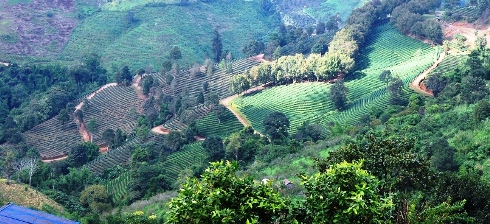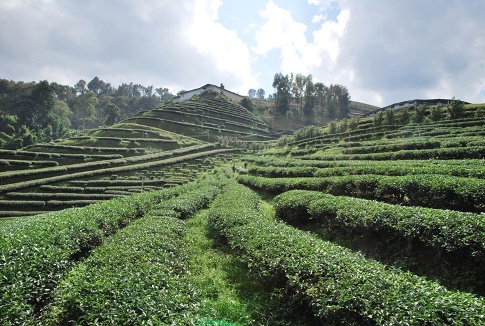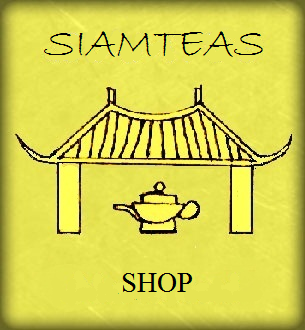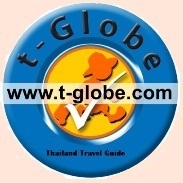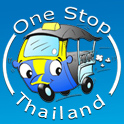Doi Mae Salong… a Chinese gem in the mountains of north Thailand, and a true Mecca for every tea lover, reachable only via a narrow road winding up the slopes alternately from Mae Chan or from Thaton, before finally revealing the pearl of north Thailand’s tea cultivation to the visitor’s eye.
The settlement had been established in the early 1950’s by remnants of Chiang Kai Shek’s counterrevolutionary Chinese Kuomintang army. After having been driven out of China by Mao Tse Tung’s “Cultural Revolution”, the Kuomintang soldiers under the command of General Lee found a new home in this no-man’s land near the Thai-Myanmar (Burma) otherwise only sparsely inhabited by some mountain tribes migrated from Yunnan. Doi Mae Salong achieved rather sad fame during the 1970s as one of the major hubs of opium trade and cultivation in the infamous Golden Triangle (Burma-Thailand-Laos). However, the eradication of the opium poppy cultivation and the drug trade enforced by highest (Royal) instance should not be the region’s last leg on its way to the history books. Much rather, Doi Mae Salong was to rise from the ashes like the proverbial Phoenix and shine in new splendor as a combination of jewel of Chinese culture, natural piece of art and center of tea cultivation in north Thailand.
When Michael Pieracci of P & T (Paper & Tea) from Berlin contacted me in February 2015 asking whether I could help him with the planning of a visit to Doi Mae Salong, this was already sort of deju-vu: while just a few years ago tea drinkers everywhere in the world were still raising their eyebrows in ironic doubt, when I was talking about Tea from north Thailand, or “Thai Oolongs“, these are virtually on everyone’s lips now. My Siam Tea Blog and the articles collected there, sticking out prominently in online searches for Doi Mae Salong or Tea Cultivation in north Thailand, seems to qualify me as an expert on the subject matter, and so hardly a week goes by, where I wouldn’t receive such or similar request for assistance with Doi Mae Salong travel plans. So, my answer has already become a standard: directions, a recommendation for accommodation in a bungalow with an overwhelming view over tea gardens, and the advice to leave everything else to chance and/or intuition.
What initially might appear to be sparse advice will soon after arrival at Doi Mae Salong turn out to be absolutely sufficient. It’s not that Doi Mae Salong “has” tea, Doi Mae Salong IS tea. The main road of the insular mountain enclave is seamed by tea factories and their pertaining roadside shops, where the producers are offering their teas. The shop fronts are wide open, and from their inside sound voices that – though not in English, but still unmistakably – call passers-by in for a free tea trial without any obligations. It’s not that the vendors wouldn’t be motivated by hopes that people will like and eventually buy their teas, but there is no felt pressure whatsoever to do so. In fact, people are still smiling and friendly when visitors step out of their shops without leaving any money, so just strolling around and checking out shops, teas and people appears to be a fully legitimate undertaking.
Characteristic for Doi Mae Salong and north Thailand are Oolong Teas: Jin Xuan Oolong No. 12, Ruan Zhi Oolong No. 17, Four Seasons Oolong, Dong Ding Oolong and Oriental Beauty Oolong Tea (Thai: “Cha Nang Ngam”), each yielded from their corresponding tea cultivars, imported from Taiwan starting from the 1980s. Besides these, the teas produced from the large-leaf tea variety native to north Thailand, which is closely related to the Yunnan „ancient tea tree”, contribute to the diversity of the northern Thai tea landscape and underline the individual character of the same. Besides the mentioned Oolong teas, as a result of the development and improvement of tea processing know-how, also green tea and black tea, along with a number of scented teas and/or flavored teas are produced. A representative of the latter category is “Chao Khao Hom” Thai Rice Tea, which has nothing to do with Japanese Genmaicha Tea, but much rather is an exclusive tea specialty of north Thailand.
A trip to the tea gardens? You are already there! Diversely styled smaller and larger teas gardens and slopes coin the townscape of Doi Mae Salong just like the tea factories, shops and buildings in traditional Chinese architecture. Which doesn’t mean that an excursion to the surrounding wouldn’t be rewarding: “conventional“ tea gardens, where the cultivation of the above mentioned Taiwanese Oolong tea cultivars is pursued in both diversity and aesthetical perfection, take turns with areas of “cultivated wild growth” of the native tea trees. A must for each visitor is Doi Mae Salong’s “tea monument”: a park of larger-than-life teapot buildings functioning as tea rooms and other congeneric sculptures derived from the traditional Chinese tea culture.
Unique to Doi Mae Salong besides the agglomeration of Chinese culture, architecture and tea culture in its pure historical form and the region’s natural attractions is also the combination of these features with the proverbial Thai hospitality: the hearty and friendly townspeople welcome every visitor like a sight for sore eyes. Beyond this, the region captures with its colorful multi-ethnic mix and the cultural diversity coming along with it: dispersed in the surrounding mountains are the villages of at least 6 different mountain tribes migrated from Yunnan during the 19th and 20th century: Lisor (Lisu), Muser (Lahu), Ekor (Akha), Kariang (Karen), Meo (Hmong) and Yao as well as members of the Shan (Tai Yai, Dai) ethnicity still pursue their traditional cultures, heritage and customs quite vividly despite the obvious impact of modern times and “civilization”.
Of all things, Michael had timed their visit to Doi Mae Salong to coincide with the Thai New Year, held April 13 – 14. Not exactly the best time to find a vacant room, but nevertheless in the young spring time, and what time could be better to visit a tea Mecca such as Doi Mae Salong than the young spring time, when the local tea producers are offering their fresh “First Flush” teas from the early spring harvest in their shops for degustation? Thanks to my prior recommendations, Michael had managed in time to make a reservation for my personal favorite spot on earth: a spacious bungalow in the middle of Doi Mae Salong, throning over the tea gardens of Khum Nai Pol Resort, whose porch offers the guest a truly spectacular view over the artfully styled tea gardens and the picturesque town with its Chinese architecture in the backdrop of a stunning mountain panorama below. As foreseen, everything else just fell into place… their friendly and helpful host organized a guided tour to the 101 tea gardens and factory, the largest local tea producer company, and also made sure that the guests were taken well care of in every other regard.
Michael spent his time on the above mentioned „legendary“ porch with an interesting experiment: with the modest means of a traveler (shadow for wilting, sun for drying, and an alienated water heater for fixating), he „processed“ a few handful of tea leaves, self-picked from the tea garden to his feet, to… hmm, yeah, to what actually? Hard to say, on Michael’s pictures it looks like Bai Mu Dan (White Peony) somehow, but please have a look for yourself and find out by reading Michael’s blog:
A visit to Doi Mae Salong – by Michael Pieracci
When Michael’s updates, pictures and feedbacks live from Doi Mae Salong (via world wide web) and finally his above linked blog, created after his return to “civilization“, reached me in my temporary residence in the tiny village of Nonnweiler-Otzenhausen located in Saarland, Germany, this made me browsing some collections of pictures I took at Doi Mae Salong during 2013s. Doing so, I came across the pictures published here, of which I believe that I did not get to use them in previous publications in Siam Tea Blog yet, and before the day was over I had typed the words you just read to go here along with them.
Tea from Doi Mae Salong in selected premium quality is available from SiamTeas, the north Thailand specialist, at
For more information about Doi Mae Salong, north Thailand, please also read our blog articles
and
Doi Mae Salong – Center of Tea Cultivation in North Thailand





